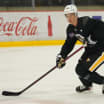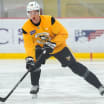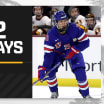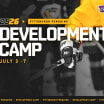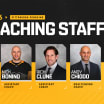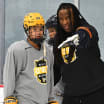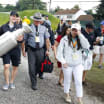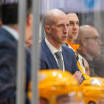Constantly Evolving With Consistent Drive and Commitment
That's what has allowed Sidney Crosby to play at such a high level for 1,000 games
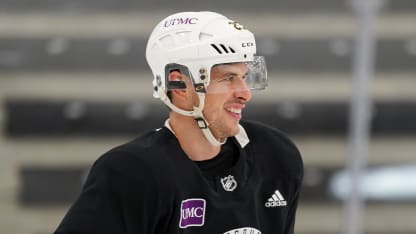
"He's always trying to learn from the game," Bryan Rust said of the 33-year-old superstar, now in his 16th NHL season. "The game has changed quite a bit since he came into the league, and he's just been taking it in stride and just getting better and better."
Before taking over as head coach of the Penguins, Mike Sullivan spent time behind the bench with Boston, the New York Rangers and Vancouver. And any time his teams faced Crosby and the Penguins, he said it was a 'nightmare' trying to contain the captain.
As Sullivan said, Crosby has the most mature 200-foot game in hockey - just as dynamic defensively as he is offensively - and no one is better than him below the goal line.
"Just his ability to play in traffic and create offense through that trench warfare in the battle areas - he's the best that I've ever witnessed in the game," Sullivan said. "Watching him perform the way he did when I was on the other side trying to figure out a way to neutralize them, that's always one of the biggest challenges for any team that has to play that has to play against them or coach against him."
It's one that Barry Trotz has faced many times as head coach of Nashville, Washington and now the New York Islanders. Crosby earned two assists against his team on Saturday night to help Pittsburgh earn a 3-2 victory in that milestone game.
Trotz said his approach to defending against Crosby is to always be aware of where he is, along with the potential passes and plays the captain can make.
"He's always going to damage you," Trotz said. "You've just got manage the damage. Because he's been effective for the length of his career. The best way is to stay on top of him, to take away his time and space, but you can't (overplay) him because he'll make plays through two or three people. He can make long plays; he can make tight plays. Control his stick, control the people around him and try to minimize the damage. That's how I look at playing Sid Crosby."
But while Crosby has made the necessary adjustments over the years so that he can keep wreaking havoc on his opponents in such a way, the intangibles he's possessed ever since he was a kid growing up in Cole Harbour are a big part of it as well.
"His work ethic and his willingness to put the work in each and every day is what makes him the player that he is," Sullivan said.
Max Talbot was teammates with Crosby from his rookie season until 2011. He laughingly remembers getting ticked off on occasion because early in his career, Crosby would never take an optional skate off.
"The guy would play over 20 minutes a night, and I would be the one playing 12 minutes, but I wanted to go out on Saturday night," Talbot recalled. "So let's say on Sunday, if there was an optional skate - he would be out there. And it's like ah, Sid is skating, that means everybody's got to skate (laughs).
"The guy just wanted to be on the ice. He said he loved it so much and his mentality was about getting better every day. So every time he had a chance to be on the ice and do what he loves so much, he was out there."
And Crosby influenced those around him to work harder just so they could keep up.
"I think the first thing that really told me he was different or showed me that he was different was his drive," said Bill Guerin, who joined the Penguins at the trade deadline in 2009. "We all have our good days and bad days, but man, his drive is there every day. I'd give him (crap) because I was old as dirt when I was playing with him. But his drive made me a better player at 38, 39 years old. I could manage a practice pretty well by that point in time and get what I needed. But then I had to practice with him full tilt and I'm like whoa, settle down there, kid (laughs)."
Armstrong said remembers having to mentally prepare himself while driving to practices, and that everyone knew they had to be ready to go once they got to the rink. That accountability is one example of Crosby's leadership and how he helps inspire those around him to be at their best.
"If you are not dialed in, he'll leave you in the dust," Armstrong said. "You are just not going to keep up because his level is so high every day. You knew the practice was going to be so high-tempo and so intense and really competitive. So you had to be ready to go, or else it just looked really bad. He wouldn't care. He would just leave; he would just be gone. And if you were partnered with him in certain drills, if it wasn't there, it was like beat it dude. I need guys who are going to keep up."
But for as much as his teammates have to prepare to reach Crosby's level, it's not necessarily something that comes naturally to him. Both Talbot and Armstrong laughed while recounting a story of how Crosby took two days off around Christmas one year so that he could go home and spend the holidays with his family.
"He came back the day of the practice, arrived just in time to the rink from the flight," Armstrong said. "Got to the rink. We're all out there. We're all happy. It's Christmas, first day back. Sid comes on. He can't like skate (laughs). He's losing the puck. It was hilarious. He was laughing too, because it was so bad."
"I was like oh my God, he's human!" Talbot added with a laugh. "Because he just didn't have it this practice and I was like, so happy. He puts the work in."
Though as he's gotten older, Crosby has started to take those optional skates off, depending on the situation. As much as he'd still probably like to be on the ice every chance he gets, Crosby understands that in order to maximize his gifts, he has to be smart about it.
"The way he treats his body and how seriously and responsibly he takes recovery and nutrition and to make sure his body's right and kind of just listen to what he needs, I think that helps his longevity," Rust said.
But the commitment to working on all the details of his game every single day, whether it's during the season or offseason, remains steadfast. Crosby continues to set goals for himself in areas where he thinks he needs to improve and get better.
As Talbot recalled, when Crosby first entered the league, he didn't have the strongest shot. And after his fourth season, he made a slight adjustment to the curve on his stick before going back to Nova Scotia for the summer, saying he knew that he could score 50.
"Between the lake and the fishing, he worked on his shot every day," Talbot said. "Gets 51 goals the season after. Same thing for his faceoffs. He was not great on faceoffs when he started in the league. Realized it, people told him, watched some tapes, worked at it and got better at it. A player like this could say oh, I'm the best. I'm already good enough. But he is really trying to get better every day, even at this age."
It's an incredible example not just to his teammates, but other players around the league - like Connor McDavid, another generational talent who wants to emulate Crosby where it matters most.
"He's been so successful in this league and done everything I want to do," McDavid said. "He's a great guy to follow. He's done everything he set his mind to. He wanted to get better on faceoffs and he did that. He wanted to score more goals and he did that. I think there's definitely lots of lessons from his game, because his game has kind of changed over the years. He does whatever he can to be successful. He's solid defensively."
While McDavid is part of a group of young superstars, along with players like Toronto's Auston Matthews and Colorado's Nathan MacKinnon, who are unbelievable talents that are producing staggering amounts of points - Sullivan warned that Crosby isn't going anywhere.
"He's not ready to relinquish, I think, the best player in the game (label) that he's carried here for a decade-plus," Sullivan said. "He's an ultra, ultra-competitive guy. There's a lot of guys that want to win, but there aren't as many that want to do what it takes to win. There's a lot of guys that want to be the best, but there aren't as many that are willing to do what it takes to be the best. And I think Sid has both of those. Not only is he a winner and a champion, but he's also willing to put the time in each and every day. And it's a daily endeavor. You don't just flip a switch and create the type of legacy that he's created. It's an impressive resume, and I don't think he's finished."

